Role Diplomat Nationality Swedish | Signature Books Markings, Castle Hill Name Dag Hammarskjold | |
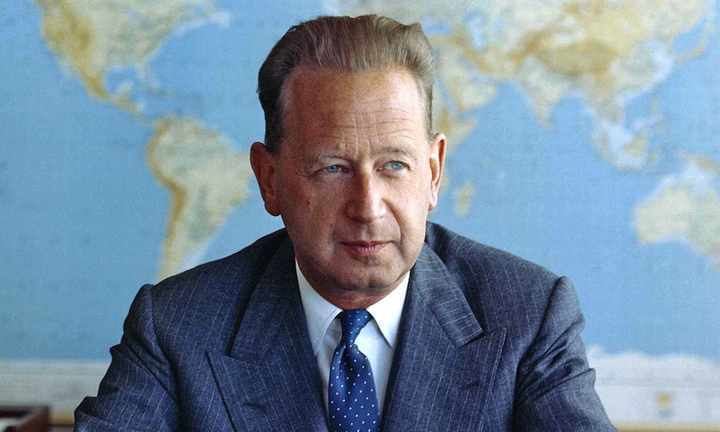 | ||
Full Name Dag Hjalmar Agne Carl Hammarskjold Religion Lutheran/Church of Sweden Siblings Ake Hammarskjold, Bo Hammarskjold, Sten Hammarskjold Similar People U Thant, Trygve Lie, Hjalmar Hammarskjold, Birgit Nilsson, Kurt Waldheim | ||
The murder of dag hammarskjold
Dag Hjalmar Agne Carl Hammarskjöld ([dɑːɡ ²hamarˌɧœld]; 29 July 1905 – 18 September 1961) was a Swedish diplomat, economist, and author, who served as the second Secretary-General of the United Nations, from April 1953 until his death in a plane crash in September 1961. At the age of 56 years and 255 days, Hammarskjöld was the youngest to have held the post. Additionally, he is one of only four people to be awarded a posthumous Nobel Prize and was the only United Nations Secretary-General to die while in office. He was killed in a Douglas DC-6 airplane crash en route to cease-fire negotiations. Hammarskjöld has been referred to as one of the two best secretaries-general, and his appointment has been mentioned as the most notable success for the UN. United States President John F. Kennedy called Hammarskjöld "the greatest statesman of our century."
Contents
- The murder of dag hammarskjold
- Dag hammarskjold har omkommit och sverige sorjer
- Early life and education
- Career
- United Nations Secretary General
- Death
- Spirituality and Markings
- Honors
- Quotes
- Peoples views
- Eponymous structures
- Other commemorations
- References
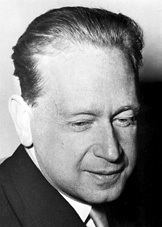
Dag hammarskjold har omkommit och sverige sorjer
Early life and education
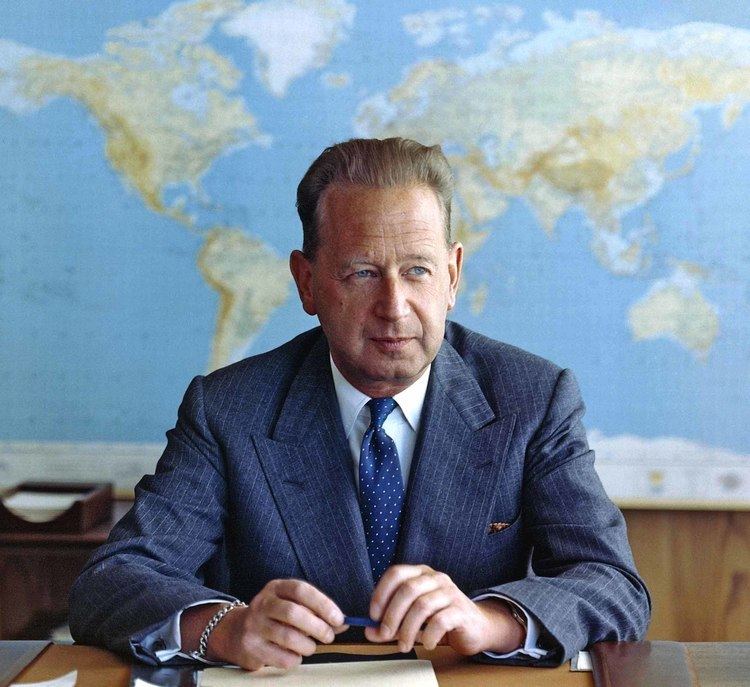
Dag Hammarskjöld was born in Jönköping to the noble family Hammarskjöld (alternatively spelt Hammarskiöld or Hammarsköld). His family was ennobled in 1610 due to deeds of the warrior Peder Mikaelsson (after 1610) Hammarskiöld (approximately 1560 - 12 April 1646), an officer in the cavalry who fought for both sides in the War against Sigismund, where he took the name Hammarskiöld at his ennobling. Dag Hammarskjöd spent most of his childhood in Uppsala. His home there, which he considered his childhood home, was Uppsala Castle. The fourth and youngest son of Hjalmar Hammarskjöld, Prime Minister of Sweden from 1914 to 1917, and Agnes Hammarskjöld (née Almquist), Hammarskjöld's ancestors had served the Monarchy of Sweden since the 17th century.
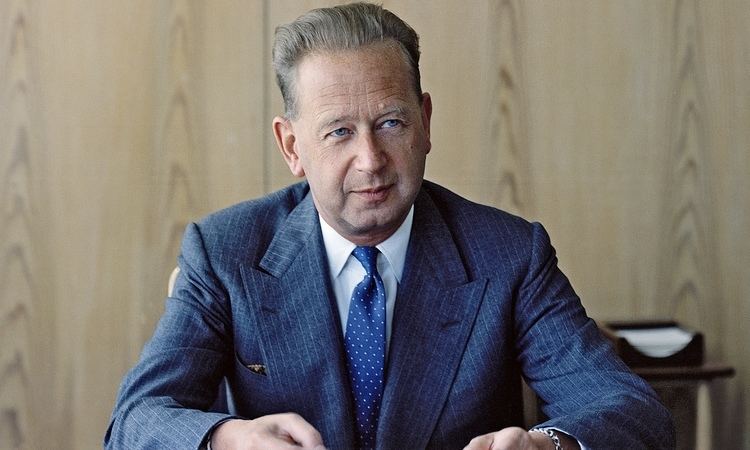
Hammarskjöld studied first at Katedralskolan and then at Uppsala University. By 1930, he had obtained Licentiate of Philosophy and Master of Laws degrees. Before he finished his law degree he had already obtained a job as Assistant Secretary of the Unemployment Committee.
Career
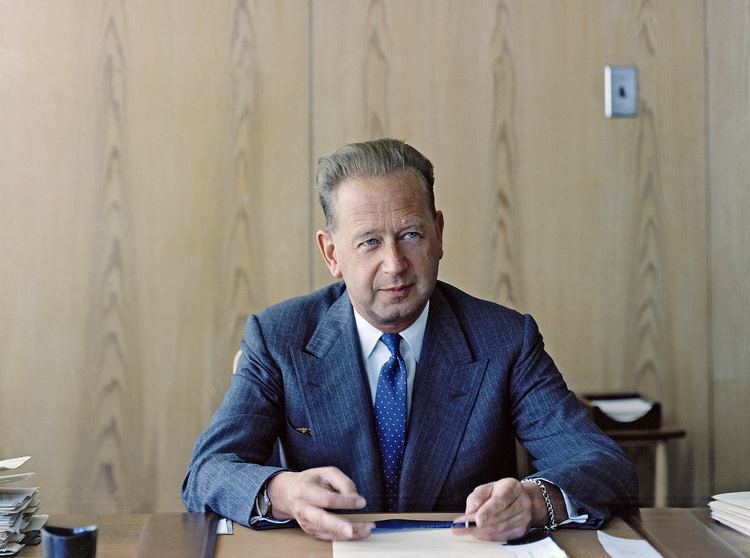
From 1930 to 1934, Hammarskjöld was Secretary of a governmental committee on unemployment. During this time he wrote his economics thesis, "Konjunkturspridningen" ("The Spread of the Business Cycle"), and received a doctorate from Stockholm University. In 1936, he became secretary of the Sveriges Riksbank and was soon promoted. From 1941 to 1948, he served as chairman of the bank.
Hammarskjöld quickly developed a successful career as a Swedish public servant. He was secretary of the Riksbank (the central bank of Sweden) 1935–1941, state secretary in the Ministry of Finance 1936–1945, governor of the Riksbank 1941–1948, Swedish delegate to the OEEC (Organization for European Economic Cooperation) 1947–1953, cabinet secretary for the Ministry of Foreign Affairs 1949–1951 and minister without portfolio in Tage Erlander's government 1951–1953.
He helped coordinate government plans to alleviate the economic problems of the post-World War II period and was a delegate to the Paris conference that established the Marshall Plan. In 1950, he became head of the Swedish delegation to UNISCAN. Although Hammarskjöld served in a cabinet dominated by the Social Democrats, he never officially joined any political party.
In 1951, Hammarskjöld was vice chairman of the Swedish delegation to the United Nations General Assembly in Paris. He became the chairman of the Swedish delegation to the General Assembly in New York in 1952. On 20 December 1954, he was elected to take his father's vacated seat in the Swedish Academy.
United Nations Secretary-General
When Trygve Lie resigned from his post as UN Secretary-General in 1953, the United Nations Security Council recommended Hammarskjöld to succeed him. It came as a surprise to Hammarskjöld. Seen as a competent technocrat without political views, he was selected on 31 March by a majority of 10 out of 11 Security Council members. The UN General Assembly elected him in the 7–10 April session by 57 votes out of 60. In 1957, he was re-elected.
Hammarskjöld began his term by establishing his own secretariat of 4,000 administrators and setting up regulations that defined their responsibilities. He was also actively engaged in smaller projects relating to the UN working environment. For example, he planned and supervised every detail in the creation of a "meditation room" at the UN headquarters. This is a place dedicated to silence, where people can withdraw into themselves, regardless of their faith, creed, or religion.
During his term, Hammarskjöld tried to smooth relations between Israel and the Arab states. Other highlights include a 1955 visit to China to negotiate the release of 11 captured US pilots who had served in the Korean War, the 1956 establishment of the United Nations Emergency Force, and his intervention in the 1956 Suez Crisis. He is given credit by some historians for allowing participation of the Holy See within the United Nations that year.
In 1960, the former Belgian Congo and then newly independent Congo asked for UN aid in defusing the Congo Crisis. Hammarskjöld made four trips to Congo, but his efforts toward the decolonisation of Africa were considered insufficient by the Soviet Union; in September 1960, the Soviet government denounced his decision to send a UN emergency force to keep the peace. They demanded his resignation and the replacement of the office of Secretary-General by a three-man directorate with a built-in veto, the "troika." The objective was, citing the memoirs of Soviet leader Nikita Khrushchev, to "equally represent interests of three groups of countries: capitalist, socialist and recently independent."
Death
In September 1961, Hammarskjöld learned about fighting between "non-combatant" UN forces and Moise Tshombe's Katangese troops. Hammarskjöld was en route to negotiate a cease-fire on 18 September when his Douglas DC-6 airliner SE-BDY crashed with no survivors near Ndola, Northern Rhodesia (now Zambia). Hammarskjöld and 15 others perished in the crash, whose circumstances are still unclear. There is some evidence that suggests the plane was shot down.
Göran Björkdahl (a Swedish aid worker) wrote in 2011 that he believed Dag Hammarskjöld's death was a murder committed, in part, to benefit mining companies like Union Minière, after Hammarskjöld had made the UN intervene in the Katanga crisis. Björkdahl based his assertion on interviews with witnesses of the plane crash, near the border of the DRC with Zambia, and on archival documents. Former U.S. President Harry Truman commented that Hammarskjöld "was on the point of getting something done when they killed him. Notice that I said 'when they killed him'."
On 16 March 2015, United Nations Secretary-General Ban Ki-moon appointed members to an Independent Panel of Experts which would examine new information related to Hammarskjöld's death. The three-member panel, led by Mohamed Chande Othman, the chief justice of Tanzania, also included Kerryn Macaulay (Australia's representative to ICAO) and Henrik Larsen (a ballistics expert from the Danish National Police). The panel's 99-page report, released 6 July 2015, assigned "moderate" value to nine new eyewitness accounts and transcripts of radio transmissions. Those accounts suggested that Hammarskjöld's plane was already on fire as it landed, and that other jet aircraft and intelligence agents were nearby.
Spirituality and Markings
In 1953, soon after his appointment as United Nations Secretary-General, Hammarskjöld was interviewed on radio by Edward R. Murrow. In this talk Hammarskjöld declared: "But the explanation of how man should live a life of active social service in full harmony with himself as a member of the community of spirit, I found in the writings of those great medieval mystics [Meister Eckhart and Jan van Ruysbroek] for whom 'self-surrender' had been the way to self-realization, and who in 'singleness of mind' and 'inwardness' had found strength to say yes to every demand which the needs of their neighbours made them face, and to say yes also to every fate life had in store for them when they followed the call of duty as they understood it."
Hammarskjöld's only book, Vägmärken (Markings), was published in 1963. A collection of his diary reflections, the book starts in 1925, when he was 20 years old, and ends the month before his death in 1961. This diary was found in his New York house, after his death, along with an undated letter addressed to then Swedish Permanent Under-Secretary for Foreign Affairs, Leif Belfrage. In this letter, Hammarskjöld wrote: "These entries provide the only true 'profile' that can be drawn ... If you find them worth publishing, you have my permission to do so". The foreword is written by W.H. Auden, a friend of Hammarskjöld's.
Markings was described by the late theologian, Henry P. Van Dusen, as "the noblest self-disclosure of spiritual struggle and triumph, perhaps the greatest testament of personal faith written ... in the heat of professional life and amidst the most exacting responsibilities for world peace and order." Hammarskjöld wrote, for example, "We are not permitted to choose the frame of our destiny. But what we put into it is ours. He who wills adventure will experience it – according to the measure of his courage. He who wills sacrifice will be sacrificed – according to the measure of his purity of heart."
Markings is characterised by Hammarskjöld's intermingling of prose and haiku poetry in a manner exemplified by the 17th-century Japanese poet Basho in his Narrow Roads to the Deep North. In his foreword to Markings, the English poet W. H. Auden quotes Hammarskjöld as stating: "In our age, the road to holiness necessarily passes through the world of action."
The Evangelical Lutheran Church in America commemorates the life of Hammarskjöld as a renewer of society, on the anniversary of his death, 18 September.
Honors
Quotes
People's views
Eponymous structures
Other commemorations
Quotes
Friendship needs no words - it is solitude delivered from the anguish of loneliness
Never - for the sake of peace and quiet - deny your own experience or convictions
Never measure the height of a mountain until you have reached the top Then you will see how low it was
